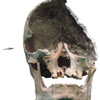Willem II of Floris de Voogd?
DOI:
https://doi.org/10.18352/bmgn-lchr.10146Keywords:
monarchyAbstract
William II or Florence the Guardian
William II, count of Holland and King of the Holy Roman Empire from 1247 to 1256, the year in which he was murdered by rebellious West-Frisians, was buried in the abbey of Middelburg. After the Reformation the abbey church was transformed into a Protestant church and the shrine of William II was forgotten. However, it was rediscovered in 1817 in a niche in the south wall where it was hidden until then by a brick wall.
Soon after the discovery an ongoing dispute among historians about the identity of the skeleton took place because a tombstone in the niche had only the arms of the counts of Holland. This suggested that the skeleton could not be that of William II but of his younger brother Floris the Guardian (†1258). The arguments for both possibilities will be discussed in this article together with the results of modern scientific investigation of the skeleton made in 2011. Based on all available information we conclude that it is that of William II.
This article is part of the discussion forum 'At the Meeting Point of Historical Disciplines'.
Willem II, graaf van Holland en Roomskoning van 1247 tot 1256, het jaar waarin hij tijdens een expeditie naar het opstandige West-Friesland werd vermoord, was bijgezet in de abdijkerk van Middelburg, in een kist boven de grond. Na de Reformatie werd de abdijkerk voor de protestantse eredienst ingericht. De plaats waar de kist stond raakte in vergetelheid tot hij in 1817 werd ontdekt in een nis in de zuidwand van de kerk, verborgen achter een bakstenen muur.
Al spoedig na de ontdekking ontstond een nog altijd voortdurende discussie over de identiteit van het skelet. De aanwezigheid van een zerk in de nis, waarop een ridderfiguur met alleen het wapen van de graven van Holland deed sommige historici veronderstellen dat het aangetroffen skelet niet van Willem II zou zijn, maar dat van zijn broer Floris de Voogd (†1258). De argumenten voor en tegen worden in deze bijdrage besproken, tezamen met de resultaten van het natuurwetenschappelijk onderzoek dat in 2011 kon worden uitgevoerd. De aldus verkregen gegevens laten ons inziens geen andere conclusie toe dan dat het onderzochte skelet dat van Willem II is.
Dit artikel maakt deel uit van het discussiedossier 'Op het raakvlak van historische disciplines'.
Downloads

Published
Issue
Section
License
Authors who publish with this journal agree to the following terms:
a) Authors retain copyright and grant the journal right of first publication with the work simultaneously licensed under a Creative Commons Attribution 4.0 International (CC BY 4.0) that allows others to share the work with an acknowledgement of the work's authorship and initial publication in this journal.
b) Authors are able to enter into separate, additional contractual arrangements for the non-exclusive distribution of the journal's published version of the work (e.g., post it to an institutional repository or publish it in a book), with an acknowledgement of its initial publication in this journal.
c) Authors are permitted to post their work online (e.g., in institutional repositories or on their website) prior to and during the submission process.
Authors are explicitly encouraged to deposit their published article in their institutional repository.







